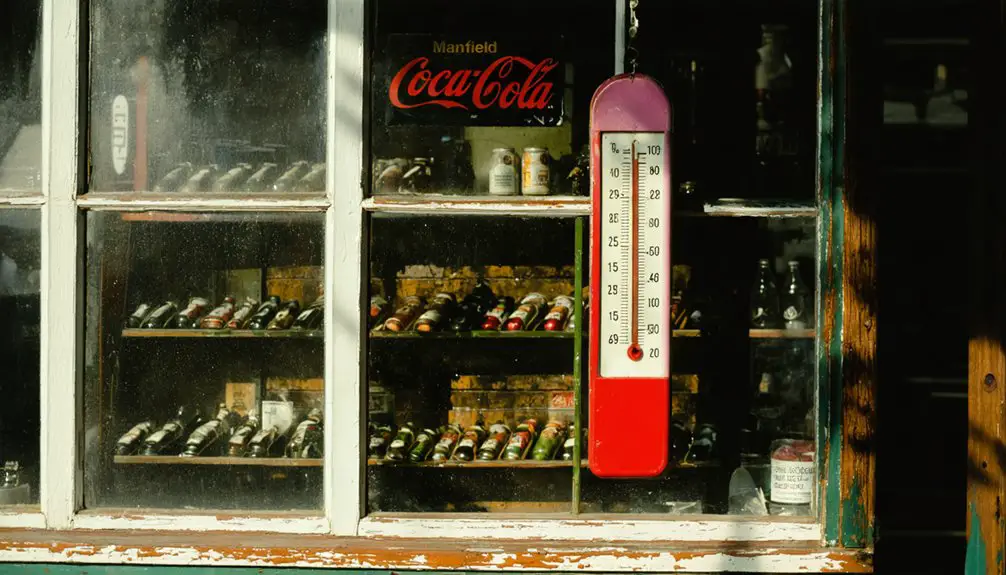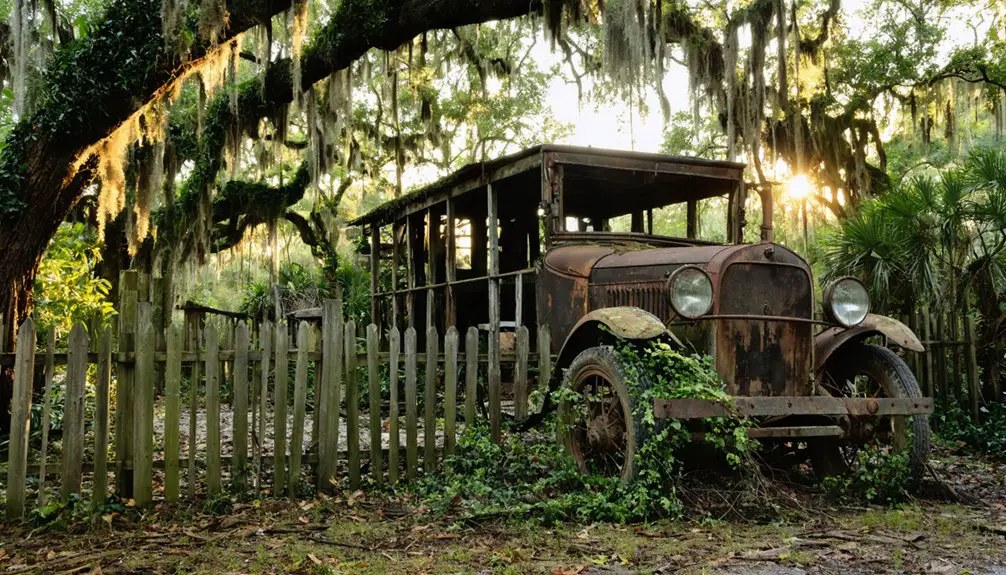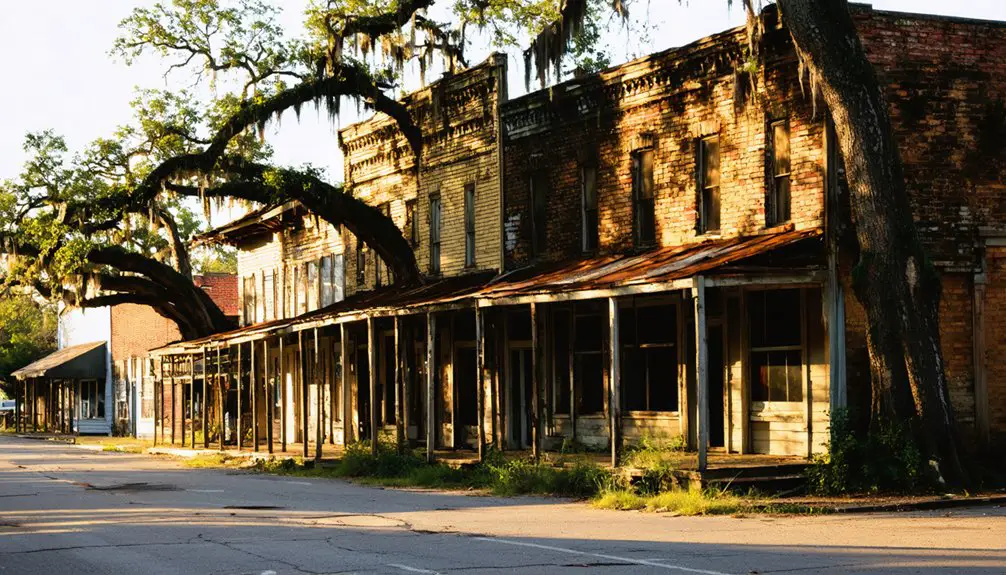You’ll find Mannfield’s haunting remains in Florida’s Withlacoochee State Forest, where this pioneer settlement once thrived as Citrus County’s temporary seat. Founded in 1884 by State Senator Austin Mann, the town boasted 250 residents, orange groves, and essential services until losing a heated county seat battle to Inverness in 1891. The mysterious “Stairway to Hell” and hidden building foundations now tell tales of political intrigue and broken dreams beneath the forest canopy.
Key Takeaways
- Mannfield was established in 1884 by Austin Mann in Citrus County, Florida, growing to 250 residents before becoming a ghost town.
- The town lost its county seat status to Inverness in 1891 after a disputed election, leading to violent confrontations.
- Railroad companies bypassed Mannfield for Inverness in 1893, triggering economic decline and eventual abandonment by early 1900s.
- Remnants include the “Stairway to Hell” root cellar, building foundations, and a historic cemetery in Withlacoochee State Forest.
- The ghost town’s ruins are now preserved for heritage tourism, with guided hikes and historical documentation available.
The Birth of a Pioneer Town
When Austin Shuey Mann established Mannfield in 1884, he set out to create more than just another Florida settlement.
You’ll find his vision took root in the heart of what would become Citrus County, where pioneer challenges didn’t deter the 250 settlers who’d ventured from 16 different states, mainly Indiana, to build their dreams.
Mann’s expertise in citrus cultivation showed in his expansive orange groves along Crystal River, setting an example for agricultural development in the region.
The town quickly grew into a bustling community, complete with churches, stores, and essential services.
You’d have found a sawmill processing local timber, three general stores serving daily needs, and a hotel welcoming new arrivals.
Mail service ran four days weekly, connecting you to the outside world through nearby Cedar Key.
In 1887, the growing settlement achieved a significant milestone when it was named the temporary county seat of Citrus County.
The town’s eventual decline began when the railroad bypassed Mansfield, shifting economic growth toward other developing communities.
Austin Mann’s Vision and Legacy
As Florida State Senator and later Representative, Austin Mann wielded considerable political influence to shape Citrus County’s destiny through his vision for Mannfield. His ambitions for the region were backed by significant landholdings, including one of the area’s largest orange groves along Crystal River.
You’ll find Mann’s legacy intertwined with the 1887 legislation that split Hernando County, creating Citrus County with Mannfield as its temporary seat. His story and influence are preserved through rare archival documents that provide insight into early Florida politics. The town grew to include 250 residents along with essential businesses during its peak.
Through his daughter’s marriage to future governor William Sherman Jennings, Mann strengthened his political connections while advancing his vision of Mannfield as a thriving hub of citrus cultivation and commerce.
Mann’s political ambitions for Mannfield grew stronger through family ties when his daughter married future Florida governor Jennings.
Though the town ultimately declined when the railroad bypassed it for Inverness, Mann’s influence on regional development and governance left an indelible mark on Florida’s west coast.
Early Days as County Seat
Mann’s political influence bore fruit in 1887 when the newly formed Citrus County designated Mannfield as its temporary seat of government.
You’ll find that during this period of temporary governance, the town’s population swelled to around 250 residents, making it a modest but significant hub of civic activity.
The town quickly established basic civic institutions, with county operations running from rented spaces owned by local residents.
After six contentious elections, eight votes ultimately determined Mannfield would lose its county seat status.
The Citrus County Star newspaper launched during this time, becoming the area’s first local press.
While Mannfield’s infrastructure remained modest, reflecting its provisional status, you’d have found a bustling sawmill and various businesses supporting the local economy.
The town’s position near the geographic center of the new county initially seemed advantageous, though limited transportation links would later prove challenging.
The town’s decline began in 1891 when officials relocated the county seat to Inverness.
Life in 1880s Mannfield
Life in 1880s Mannfield revolved around a thriving agricultural economy anchored by citrus farming and livestock operations.
You’d find bustling activity at Austin Mann’s extensive orange groves and the local sawmill, while cattle and sheep grazed on surrounding pasturelands. The town’s three general stores served as hubs where you could purchase supplies and catch up on local news.
Community gatherings centered around the church and school, while the local newspaper kept you informed of important events. The town’s turpentine production industry provided additional economic support for local residents. As the county seat location, Mannfield served as a crucial administrative center for the region.
Agricultural practices evolved with Mann’s irrigation company digging canals to improve crop yields. The hotel welcomed travelers, and with a population of 250, you’d know most of your neighbors.
Though tensions occasionally flared with rival Inverness, daily life maintained a steady rhythm of commerce, farming, and civic engagement.
The Political Power Struggle
The peaceful rhythms of 1880s Mannfield soon gave way to fierce political turmoil when the town’s status as county seat came under attack. Inverness, an ambitious rival town, sparked intense political tensions by challenging Mannfield’s position, citing poor road access as justification.
The county rivalry reached its climax in 1891’s controversial election, where Inverness claimed victory by just nine votes amid accusations of ballot tampering. You’d have witnessed fistfights in the streets as Mannfield’s supporters desperately fought to retain power.
When legal attempts to block the courthouse’s removal failed, the building was physically relocated to Inverness in what became known as “The Night They Stole the Courthouse.” This power shift ultimately contributed to Mannfield’s decline and eventual abandonment.
Losing the Railroad Race
While Mannfield reeled from its courthouse defeat, an even more devastating blow arrived in 1893 when railroad companies chose to route their tracks through rival Inverness instead.
You’d have seen the railroad impact ripple through Mannfield immediately – its bustling community of 250 residents watched helplessly as their town’s economic lifeline was severed. The strategic decision favored Inverness’s location and its residents’ connections to railroad companies, leaving Mannfield isolated from essential trade routes.
Without railroad access, Mannfield’s once-vibrant community watched their town’s future slip away as trade routes bypassed their streets forever.
The economic decline was swift and merciless. Mannfield’s thriving businesses – including its general store, sawmill, newspaper, hotel, church, and school – began to wither without the railroad’s promised connectivity.
As commercial activity shifted to Inverness, Mannfield’s population dwindled, marking the beginning of its transformation into a ghost town.
From Bustling Hub to Abandonment

Once home to 250 residents, Mannfield’s bustling streets began emptying after the devastating one-two punch of losing both its county seat status and railroad prospects.
Austin Shuey Mann established the ambitious settlement in 1884, envisioning it as a cornerstone of Florida’s development.
You’d have witnessed dramatic community dynamics unfold as the town’s administrative importance crumbled following the controversial 1891 election, where Inverness won by just nine votes.
The economic shifts were swift and merciless – county buildings were physically relocated, businesses shuttered, and the population dwindled.
By the early 1900s, the once-promising hub had lost its sawmill, courthouse, and most of its residents.
The town’s final appearance on Citrus County maps in 1920 marked its official fade into obscurity, leaving behind only scattered ruins and a haunting “Stairway to Hell” root cellar as evidence of its former glory.
The Mysterious Stairway to Hell
Among Mannfield’s haunting remains, a derelict stairwell known as the “Stairway to Hell” stands as the settlement’s most intriguing ruin.
You’ll find this mysterious structure hidden in the woods near Mannfield Pond, where it’s become one of Florida’s enduring urban legends. Despite its provocative name, historical evidence reveals it was simply part of a root cellar rather than a gateway to the underworld.
Today, you’ll struggle to spot the stairway through thick vegetation and termite mounds along the Florida Trail. The area east of the site lies within the Citrus Wildlife Management Area.
While local folklore has transformed this humble cellar entrance into something more sinister, its cultural significance lies in what it represents – the decay of a once-thriving county seat.
The structure continues to captivate heritage tourists and ghost town enthusiasts exploring Florida’s forgotten past.
Hidden Ruins in Withlacoochee Forest

Deep within the Lecanto Sand Hill section of Withlacoochee State Forest, you’ll discover the scattered remnants of Mannfield’s former glory. This hidden history lies east of the intersection of Route 491 and Mansfield Road, where nature has reclaimed most traces of the once-thriving town.
As you explore these forgotten landscapes, you’ll need a keen eye to spot the subtle clues of civilization among the trees.
- Building foundations peek through the forest floor near Mannfield Pond
- A historic cemetery rests peacefully within the dense woodland
- Foundational rubble marks where homes and businesses once stood
- Limited signage adds to the mysterious atmosphere of discovery
The ruins now blend seamlessly with the 157,479-acre forest, creating an adventurous journey through time for those willing to seek out Mannfield’s secrets.
Preserving Mannfield’s Memory
While Mannfield’s physical structures have largely vanished into the forest, dedicated preservation efforts guarantee its legacy endures.
You’ll find strong community involvement in protecting what remains, particularly at the historic cemetery where local volunteers maintain fencing and conduct regular cleanups. The Citrus County Historical Resources Office preserves vital documentation, including maps, photographs, and oral histories from descendants of early residents.
Today, historical preservation takes many forms: guided hikes through marked trails let you explore the remnants responsibly, while digital archives and museum exhibits share Mannfield’s story with future generations.
Federal protection since the late 1930s assures the site remains safeguarded from development, and strict regulations prohibit artifact collection or excavation, protecting this slice of Florida’s past for years to come.
Frequently Asked Questions
What Happened to Austin Mann After Mannfield Lost Its County Seat Status?
Despite Mannfield’s decline, you’ll find Austin Mann’s legacy continued through his orange grove operations, Florida House service in 1891, and regional influence until his death in 1914 in Citrus County.
Were There Any Notable Crimes or Lawlessness During Mannfield’s Brief Existence?
Like a peaceful pond reflecting Florida’s pines, you’d find Mannfield was remarkably calm. Historical records show no documented crime statistics or major law enforcement incidents during its brief period as county seat.
What Indigenous Peoples Inhabited the Mannfield Area Before Its Establishment?
You’ll find the Orange people occupied the area from 2000-500 BC, followed by the St. Johns tribe until 1500 AD. Later, Creek migrants formed the Seminole nation, making this their cultural heritage.
Did Any Famous Visitors or Notable Figures Stay at Mannfield’s Hotel?
You won’t find records of any famous guests at Mannfield’s hotel, despite thousands checking local archives. While political figures may have visited during its county seat days, there’s no documented hotel history.
How Many People Lived in Mannfield During Its Peak Population?
You’ll find that Mannfield reached its historical significance with 250 residents during 1886-1887 while serving as county seat, though this population wouldn’t last through the town’s eventual decline.
References
- https://abandonedfl.com/mannfield/
- https://cccourthouse.org/wp-content/uploads/2023/12/Ghost-towns-and-Cemeteries-of-Citrus-County.pdf
- https://www.youtube.com/watch?v=uIS8Ud3gzx4
- http://www.gribblenation.org/2018/06/ghost-town-tuesday-mannfield-fl-and.html
- https://en.wikipedia.org/wiki/Mannfield
- https://www.youtube.com/watch?v=IYx5g_y6Ccs
- https://www.youtube.com/live/FpEwV1S_SCc
- https://ufdc.ufl.edu/mann
- https://naturecoaster.com/hiking-withacoochees-citrus-tract-discovering-the-remnants-of-mannfield-and-jeep-cave/
- https://en.wikipedia.org/wiki/Austin_Mann



